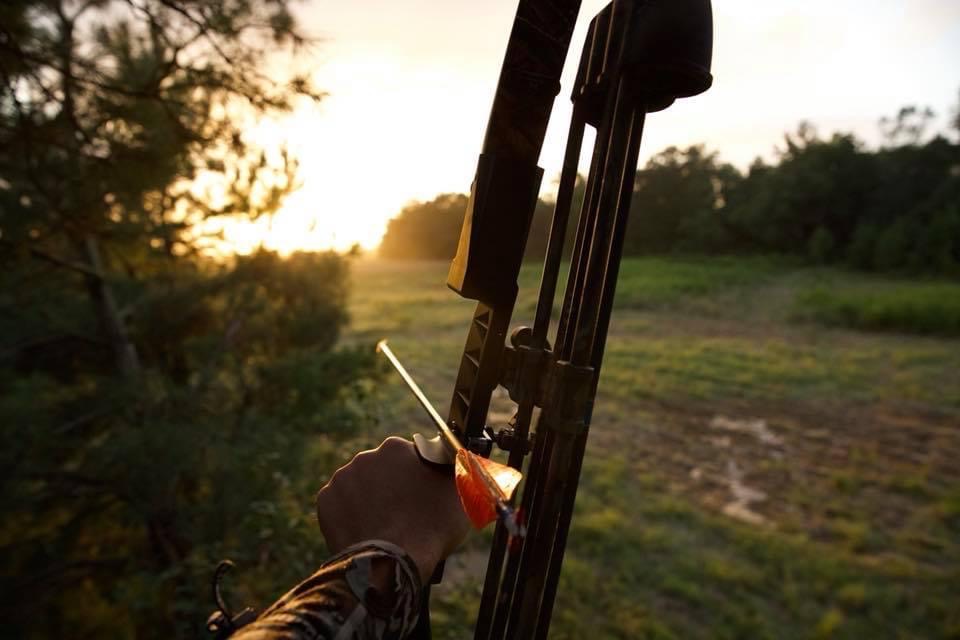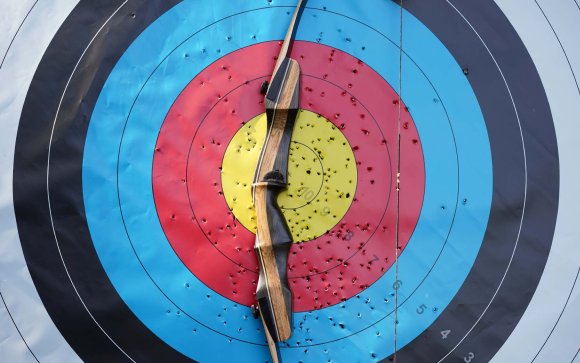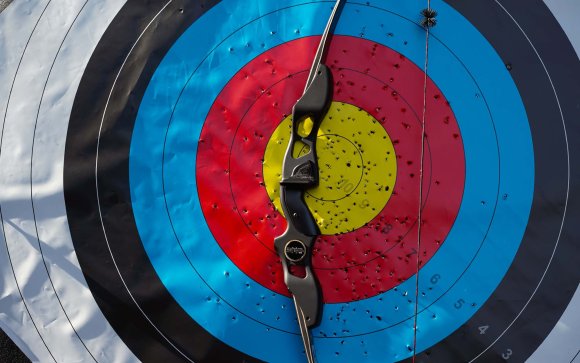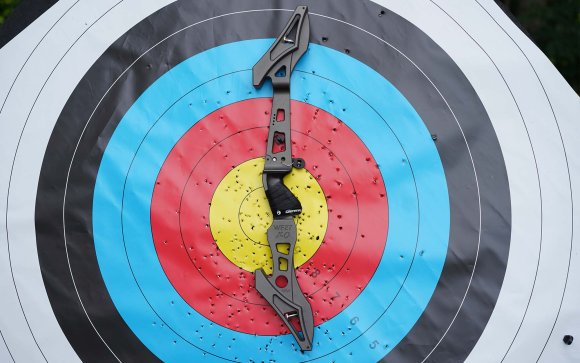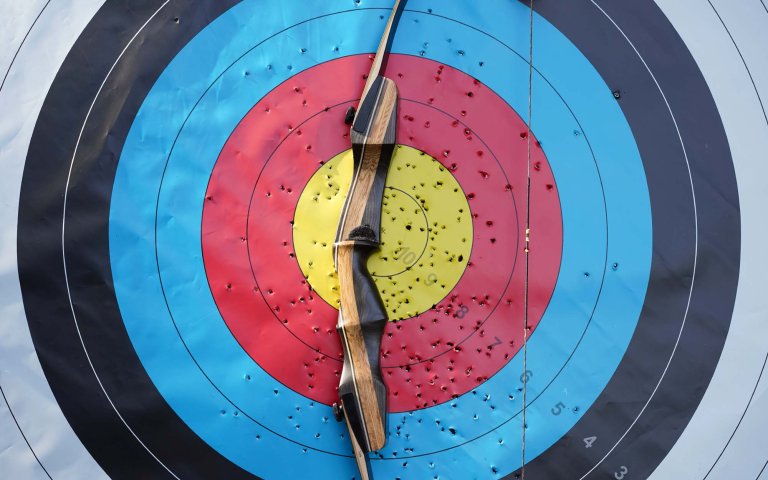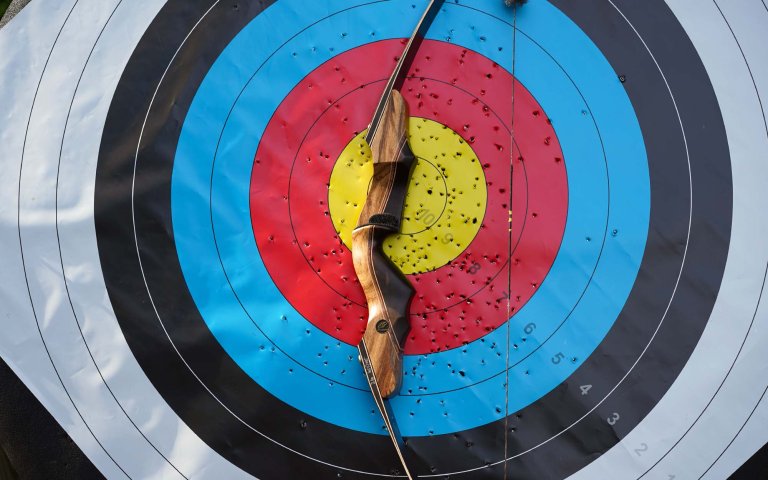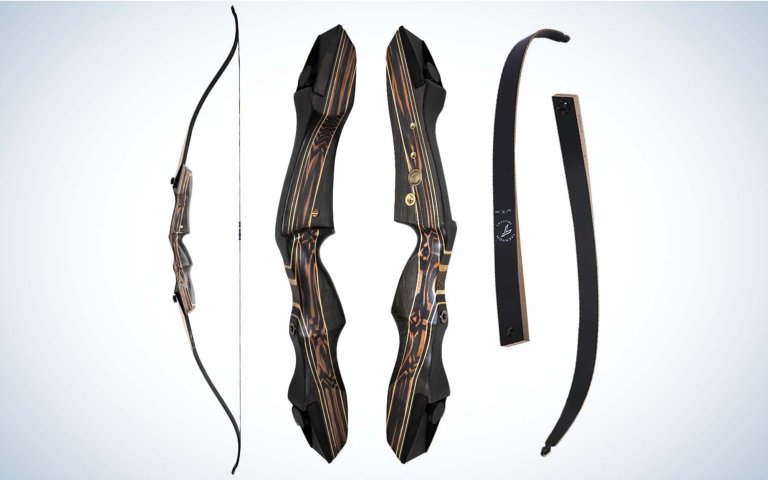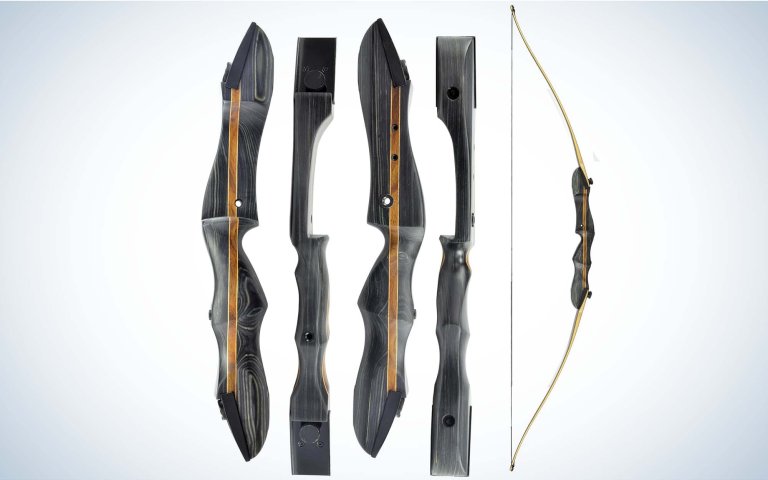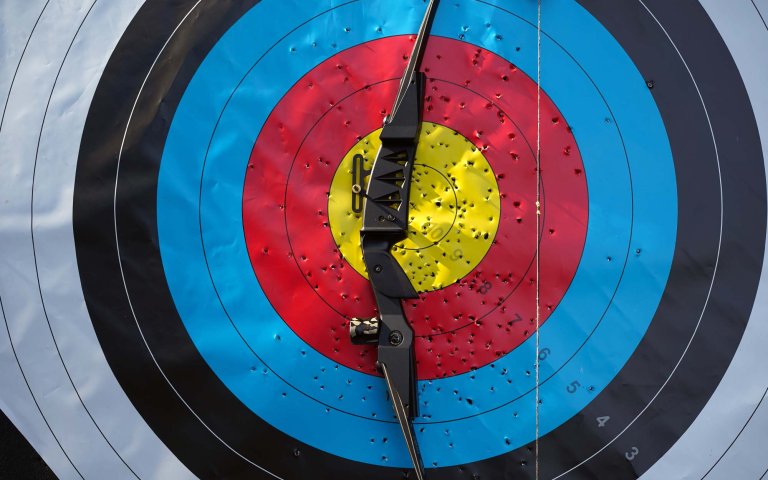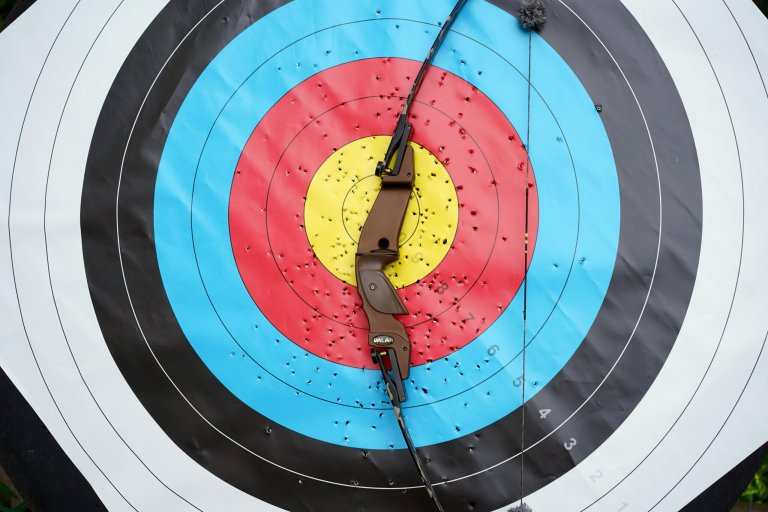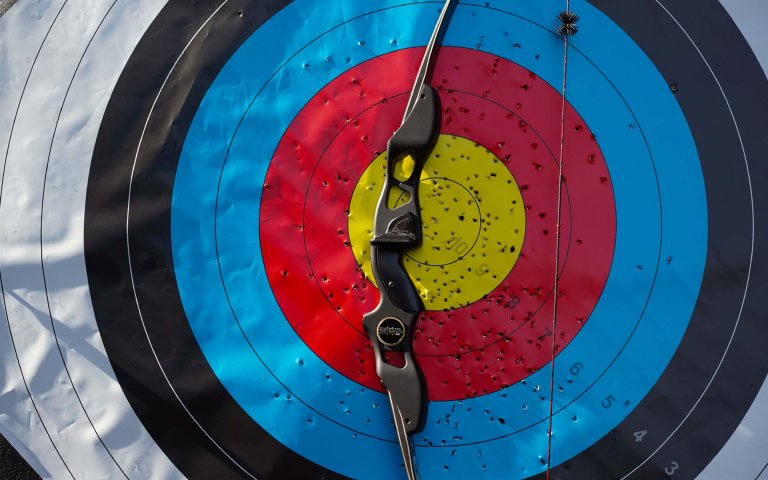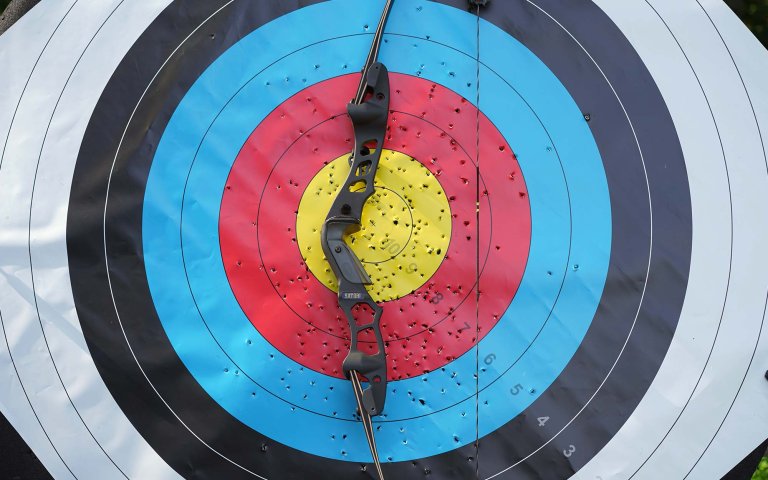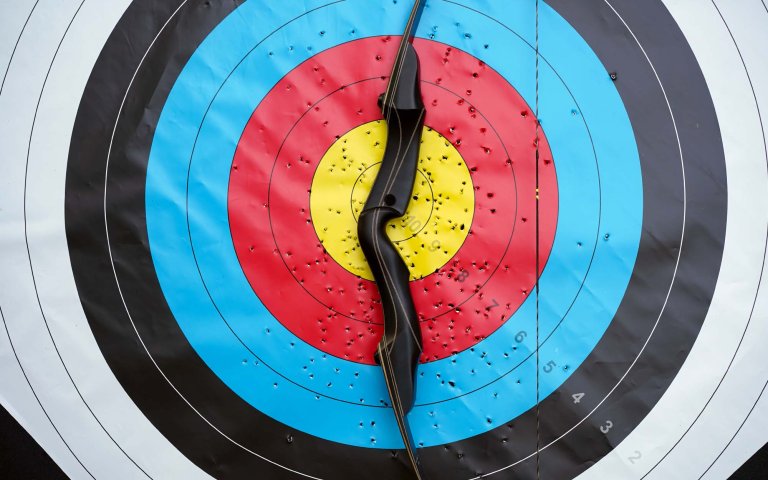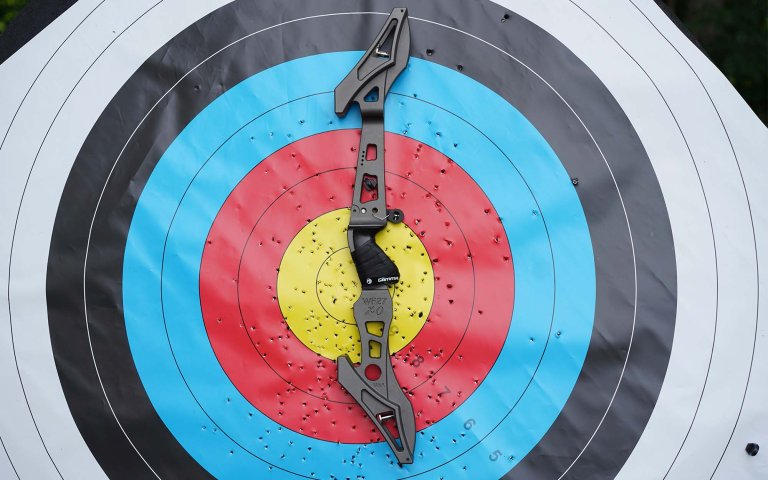We may earn revenue from the products available on this page and participate in affiliate programs. Learn More ›
Recurve bows are challenging to shoot well but all the more rewarding when you unlock the keys to accuracy. If you want to head down the trad road and embrace the challenge, you’ll need a few things to get started: coaching, patience, and the right equipment.
I’ve shot, competed, and hunted with everything from Olympic recurves to selfbows in the last 16 years. During that time I’ve owned dozens of bows. I was also an archery instructor and helped many students pick out their first bow. Over the past month, I’ve been testing some of the top readily-available recurves for their grip, features, speed, draw cycle, and shooting experience. Here’s my roster of the best recurve bows that I’ve shot.
- Best Budget: Galaxy Sage
- Best Mid-Priced: Galaxy Vega
- Best for Under $150: Tachyon Recurve
- Best Longbow Under $200: Southwest Archery Longbow
- Best for Shooting an Elevated Rest: TradTech Titan III with TradTech Carbon Wood Limbs
- Quietest Metal Riser: DAS
- Best New Riser: Amagi Archery
- Best Complete ILF Bow: Hoyt Satori
- Best Custom: Wengerd
- Best USA Made: CD Archery
- Buy Used
How I Tested the Best Recurve Bows

I can’t stress enough that there is no one best recurve bow, and choosing a bow that you like is very subjective. The absolute best way to choose one is to shoot it. But, if you can’t shoot all the bows, I reviewed them on the following criteria to help you make a decision.
Grip
I look for grips that encourage proper technique and consistent grip pressure. Bows with grips that are too rounded or wide can cause inconsistent results.
Tuning
I set up and bareshaft tuned each bow at 20 yards. This improved accuracy and helped me provide accurate speed data.
Speed
Speed was measured using a Lab Radar Chronograph, and the figure provided is based on a ten-shot average. I went to ten shots because I wasn’t using a shooting machine or draw check, and a bad release or ¼ inch of draw length variation can cause speed to vary. Not every bow tuned with the same arrow, so I listed the arrow weight for each bow in the key features section as well as the brace height and draw weight.
The speeds given must be taken with a grain of salt. There are many factors that can change a bow’s speed by 5 fps up or down, and I don’t recommend using speed as a factor for determining which bow to buy. If anything, the speed of each bow shows how similar each of these bows perform.
Shot Reaction, Sound, and Vibration
While shooting the bows, I noted the perceived vibration and sound each produced. I also took note of their post-shot reaction.
Features and Build Quality
I’ve owned some of the bows in this review for years and have hunted or competed with them. Others in the test are new to me, and I’ve only been shooting them for about a month. I’ve bought several bows that missed the mark on the details. They had poor tolerances, which meant certain limbs didn’t fit, or it was very difficult to get limbs to align. Some didn’t have set screws for key adjustment points, so the tune was always moving. Others had a riser geometry or limb design that made them difficult to shoot. I’ve also shot bows that felt like a tuning fork no matter how I tuned them or what arrows I shot.
I judged each of these bows with those poor experiences in the back of my mind.
The Bows

Most of the bows featured in this review were bought by me and are part of my personal collection. Below is a list of products I received to test for the purpose of this review:
- Samick Sage
- Galaxy Vega
- TradTech RC/Wood Limbs
- Hoyt Satori Limbs
- Amagi Riser
Best Recurve Bows: Reviews & Recommendations
Best Budget: Samick Sage
Pros
- Good performance for the money
- Easy to change limbs
Cons
- Poor quality control
Key Features
- Length: 62 inches
- Draw Weight: 46 pounds
- Speed: 154 fps
- Arrow Weight: 517 grains
- Brace Height: 7 ¾”
I’ve recommended Samick Sage recurves to many trad converts because they’re under $200, and extra limbs run around $75. That price point and the interchangeable limbs make it easy to avoid the most common mistake new archers make, which is shooting too much draw weight. I don’t care if you’re a seasoned compound shooter who normally shoots 70 pounds. Your starting recurve weight should be under 40 pounds at your draw length.
If you buy a 30-pound Sage to learn proper form but want to build up to 40 or more pounds for hunting, you can buy limbs in five-pound increments as you get stronger. You can sell the limbs you don’t need anymore to recoup some of your costs. In my opinion, it’s the best way to get started in traditional archery.
The Sage is a capable hunting or 3D archery bow with surprisingly good performance. My 46-pound Sage shot 154 fps with a 517-grain arrow at my 30-inch draw length. That falls into the fast-enough category with .354 slugs of momentum.

The Samick Sage has a medium-low wrist grip, which is a nice angle for compound converts and one that most shooters will find comfortable. I like that the grip isn’t too wide, and its shape is similar to what I prefer for competition shooting. I had no problem maintaining even grip pressure, and with a proper grip, you’ll have a hard time torquing the bow.
The limbs I usually shoot are four times the price of a complete Sage. Yes, those pricier limbs are much smoother. But the Samick Sage’s draw cycle is good enough that it won’t hurt accuracy or be uncomfortable at full draw.
One area where the Sage shows its price point is post-shot vibration. Even with the heavy arrows I was shooting, there was a fair amount of vibration after the shot, and it took longer for the Sage limbs to stop vibrating than other bows.

Another area of concern is that you’ll have to perform your own quality assurance check. I’ve set up several Sage recurves that came with twisted limbs. So, when you receive your Samick Sage, string it using a bow stringer and sight down the string. You want to look to see if you notice any twists in the limbs and that the limb tips are aligned. It will be obvious if the limbs are crooked. If your limbs aren’t straight, send the bow back and get a replacement.
I also recommend throwing out the string that comes with the bow and buying a quality bowstring. You can expect to pay $20 to $50 for quality strings from makers like Mountain Muffler, America’s Best, and OCD Strings. That’s an investment that will make your bow faster and your tune more stable. Plus, they will last longer than a cheap string.
You can buy better bows, but not for under $200. That’s why the Samick Sage is the best bow to start learning recurve form, and you can absolutely use it to hunt or shoot 3D competitions. Just keep in mind that you’ll need to do a quality check and buy a new string.
Best Mid-Priced: Galaxy Vega
Pros
- Smooth
- Quiet
- Great value for the price
Cons
- Grip might be too wide for archers with small hands
- I would prefer a more neutral grip
Key Features
- Length: 60 inches
- Draw Weight: 45 pounds
- Speed: 152
- Arrow Weight: 567 grains
- Brace Height: 7.5 inches
The Galaxy Vega is a 60-inch, three-piece recurve bow with a hardwood riser. The contrasting dark and light wood isn’t custom bow quality, but it looks very nice to my eyes. It comes with black glass limbs with a maple core.

To me, the Vega’s grip is good, not great. The left side of the grip is rounded, which can encourage an improper grip if you’re not careful, and it could be too wide for archers with small hands. With that said, I could still shoot it accurately and maintain even grip pressure—it just took more focus.
60-inch bows aren’t supposed to be smooth at long draw lengths, but I found the Vega to be a surprisingly shootable bow at my 30-inch draw. The bow steadily gains draw weight, and I can feel it starting to gain more weight-per-inch past 28 inches, but it’s not an extreme stack. Once in my holding position, I could expand without feeling like I was hitting a wall. I’d still recommend this bow for shooters with draw lengths less than 29 inches. The 62-inch Galaxy Ursa, is better for longer draws.
I was also impressed by the Vega’s lack of vibration and dead quiet shot. Granted, I used a Mountain Muffler bowstring on the Vega and heavy arrows, but I wouldn’t think twice about taking this bow after spooky southern whitetails.
The limbs come in 5-pound increments. That’s important to note because a bow that’s marked 45-pound bows might not be 45 pounds. The limbs could be 43 pounds and are marked as the closest 5-pound increment. This isn’t something unique to Galaxy bows and is very common for production bow limbs. The good news is that Lancaster Archery has great customer service, and you can contact them to make sure you get limbs that are the close to your target draw weight.
Best Under $150: Tachyon Recurve
Key Features
- Includes a string, bow stringer, strike plate, and rug rest
- Length: 62 inches
- Draw weights available: 25 to 60 pounds in 5-pound increments
- Price: $130
Test Results
- Speed: 168 fps (488 grain arrow, 31-inch draw, and 43 pound draw weight)
- 20 yard group average: 6 inches (20 shot average)
The Tachyon recurve is essentially a Samick Sage, which is a proven bow and a top-recommended budget recurve, it’s a nearly identical design. What sets the Tachyon apart is that it comes ready to shoot off the shelf. The Sage is cut well past center to allow for the use of an elevated rest and a plunger. But the Tachyon comes with a strike plate and shelf material and the riser doesn’t need to be built out to achieve proper center shot.
Another great thing about the Tachyon is that it comes with detailed instructions on how to set up the bow. That’s huge for a new archer who wants to get started on the right foot. Like many budget bows, it doesn’t come with a great string and I’d recommend upgrading it if you want to hunt with this bow.
Best Longbow Under $200: Southwest Archery Longbow
Key Features
- Includes: string, bow stringer, and flipper rest
- Length: 64 inches
- Draw weights available: 20 to 50 pounds in 5-pound increments
- Price: $175
Test Results
- Speed: 151 fps
- 20 yard group average: 6 inches
This bow is a great shooter. It’s quiet, stable, and was easy to shoot well. The limbs fit into the limb pockets snugly and there wasn’t any slop after the bolts were tightened. My main issues with this bow is that most people want to shoot a longbow off the shelf, but this bow is made for shooting off an elevated arrow rest. It doesn’t come with shelf material or a strike plate, it comes with a flipper. It’s also cut well past center so if you want to shoot off the shelf, you’ll have to build out the riser to get your center shot set. That’s a lot for a new archer to take on and a big miss on the design.
On the positive side, it’s hard to find a three piece longbow this affordable. The benefit of a takedown longbow is that you can start with a low draw weight and affordably increase your draw weight as you go.
Best for Shooting an Elevated Rest: TradTech Titan III with TradTech RC Carbon Wood Limbs
Pros
- Great for hunting
- Works well with bolt-on arrow rests and plungers
Cons
- No stock option for off-the-shelf shooting
Key Features
- Length: 64 inches
- Riser Weight: 2.3 pounds
- Draw Weight: 45
- Speed: 152 fps
- Arrow Weight: 567 grains
- Brace Height: 8.25 inches

Rob Kaufhold and the good folks at Lancaster Archery Supply are a pillar of the archery community, and TradTech is their traditional line of products. The TradTech Titan risers come in 17-inch and 19-inch lengths (the 19-inch riser is my favorite). I’ve hunted with the Titan III for years and even shot it at the IBO Traditional World Championship. TradTech also makes excellent, affordable limbs, and I’ve tested the TradTech RC Carbon/Wood limbs over the past month. While they were new to me, the RC Carbon/Wood limbs have a long reputation of being an accurate limb. Barebow G.O.A.T., John Demmer III, used them to win several tournaments.
The Titan’s stock wood grip is serviceable, but it could be better. To me, it’s much too rounded and wide for accurate shooting. Like most ILF risers, I swapped it for a grip that I shoot better.
One thing I like about the TradTech is that it has all the features I want in an ILF riser: A good limb alignment system. It has bolt holes for attaching an arrow rest and shooting a plunger. I’ve never had an issue attaching limbs from multiple manufacturers. It has a nice geometry for forgiving shooting.
I mostly shoot the TradTech with an elevated arrow rest and a plunger. It’s not the most traditional setup, but it is forgiving and accurate. I think the Titan’s wide shelf and proper mounting holes make it ideal for an elevated rest. I’ve even been using the Titan to experiment with shooting a sighted recurve for hunting.
The RC Carbon/Woods are now my favorite hunting limbs in the $500 range. Like the riser, they strike a nice balance between performance and accuracy. A nice comfortable draw is followed by a snappy release and very little post-shot vibration. They also have a matte finish for hunting, but I’ll likely apply a spray paint camo finish.
Quietest Metal Riser: DAS
Pros
- Versatile
- Nice finish
Cons
- More radius on the shelf would be preferred for off-the-shelf shooting
Key Features
- Length: 17 inches
- ILF or DAS Limb Attachment
- 6061-T6 Aluminum

DAS bows are one of the original hunting length metal recurve risers. They were originally brought to market by modern recurve pioneer, David Sosa. There’s a lot to like about DAS bows, but the signature feature is how the limbs attach. The limb attachment system used on the DAS risers combines the best attributes of ILF and bolt-down bows. Like an ILF, you get a toolless and fast takedown system, with tiller, limb alignment, and draw weight adjustment. Combined with the inherent stealth of a bolt-down bow.
DAS risers are available with DAS pads or ILF pads. I have both for my 17-inch riser, and I most commonly use the ILF configuration because I have a lot of ILF limbs that I swap between all my risers. But, I do think the DAS system is superior for hunting because it’s quieter than ILF.

DAS risers come with a Jager grip, and they offer a lot of choices when you order. I think that’s a major selling point because you get the exact grip you want without having to chuck one and spend $50 on another grip.
I typically shoot my DAS with a Springy Rest, which is a very accurate and forgiving way to shoot this riser. It also has a radiused shelf hump and an adjustable side plate for archers that want the rugged reliability of shooting off the shelf. I do wish there was a stock option to increase the amount of radius, but it’s not a difficult thing to DIY if you find you’re getting contact when shooting off the shelf.
DAS gets all the important things right with their risers: The ILF specs are accurate so you won’t have issues swapping limbs. The limb alignment adjustment works well. They’re finished nicely. The riser geometry is right in the happy medium zone. What you end up with is one of the best ILF hunting bows.
Best New ILF Riser: Amagi Archery
Pros
- Excellent for shooting off the shelf
- Perfect neutral balance
Cons
- Some archers might not like the weight
Key Features
- Length: 19 inches
- Internal weight system
- Lifetime Warranty
- Jager Best 2.0 grip
John Wert is a well-known name in traditional archery circles and helped design the TradTech risers. He recently broke the internet when he released a riser under his new company, Amagi Archery. The first batch sold out in a matter of days, but don’t worry, a resupply should arrive before hunting season. Wert’s riser design uses proven ILF geometry, with just the right amount of deflex, and some new innovations that make it stand out in this crowded product category.

One of my favorite features of the bow is how it balances. My target bow has a neutral balance, and it doesn’t roll backward on the release. The Amagi riser has the exact same balance, which makes it a stable arrow-launching platform. You can achieve that same balance on any ILF riser by screwing in a barebow weight or stabilizer into the stabilizer bushing. But, Amagi uses an integral weight for a sleek look—keeping the trad bow aesthetic. It’s very easy for me to aim steady and keep a solid follow-through with the Amagi, due to its balance. That means it’s an easy bow to be accurate with and one I trust to make up for my mistakes under pressure.

You can use a bolt-on rest and plunger, springy rest, or shoot off the shelf with the Amagi. The system Wert developed for shooting off the shelf is the best I’ve seen on an ILF recurve. It looks like it’s part of the bow, has an ideal radius, and is solid. It’s also easy to install and remove. The only thing that could make it better would be if the center shot was adjustable.
Amagi didn’t skimp on the grip, and they’ve included a Jager Best 2.0, low-wrist grip. It has the right shape and size to fit most hand sizes, and it’s a difficult grip to torque.
Wert’s innovation and contribution to trad archery is in his well-designed riser. But he’s also offering limbs to go with the riser. At this time, the limbs are a budget, sub $200, limb, and he plans to have a mid-priced limb available soon. The limbs are good for their price, and I don’t think they’re costing me much in the way of accuracy. But, I like nice limbs and I really like this riser, so it’s getting an upgrade in the way of Hoyt Velos limbs.
If you like a feather-light bow, this isn’t the riser for you. Likewise, if your bow must be made in America, this riser isn’t for you. But, if you want an ILF riser that gets all the details right, is balanced like a target bow, and has great customer service to back it up, then take a look at the Amagi.
Best Complete ILF Bow: Hoyt Satori
Pros
- Well-made riser
- Durable finish
Cons
- Only one rest bolt hole
Key Features
- Length: 66 inches
- Draw Weight: 45
- Speed: 154 fps
- Arrow Weight: 567 grains
- Brace Height: 8.5 inches
The Hoyt Satori is an ILF recurve from the company that introduced ILF technology to the world. It comes in 17-, 19-, and 21-inch lengths. They all shoot great and share the same qualities, but I prefer the 21-inch Satori. It’s not too heavy for a long riser, and it has the geometry I like. The 17-inch riser is also excellent for hunters looking for a light, compact bow they plan to shoot off the shelf.
I didn’t like the grip on the Satori and couldn’t shoot it well. The grip had a seam down the middle where the two halves were glued together, which I found uncomfortable. The good news is that it’s not a big deal on a metal riser because you can buy great grips from companies like Jager. In fact, the first thing I change on all my ILF bows is the grip. Once I had my Jager JD3 grip on the bow, my accuracy improved, and life was good.
You can buy a Satori Riser separately and attach any ILF limb to it—including Hoyt’s awesome, but pricey, Velos limbs. It’s also sold as a complete bow with Satori limbs, which are what I had on my riser. The Satori Limbs have a wood core with carbon and glass layers. The limbs feel good on the draw but don’t feel nearly as smooth as the Velos limbs. On the shot, the Satori Limbs are snappy, and they settle quickly once the arrow is gone.
Hoyt got a lot of things right on the Satori. But, one of the biggest misses is there’s just one hole for an arrow rest. That isn’t a big deal if you plan to shoot off the shelf, but it is a big deal if you want to use a cushion plunger and bolt-on arrow rest. On the flip side, the Satori has a nice system for shooting off the shelf with an adjustable side plate.
If you’re looking to buy a complete ILF bow, it’s hard to beat the Hoyt Satori. You’ll get a good riser and limbs for under $1,000, and it’s available from 60- to 66-inch lengths to fit any archer.
Best Custom: Wengerd
Pros
- High-end craftsmanship
- Great performance
Cons
- Long waitlist
Key Features
- Length: 66 inches
- Draw Weight: 40 pounds
- Speed: 160 fps
- Arrow Weight: 517 grains
- Brace Height: 8.5 inches



Trent Wengerd builds bows one at a time in his Idaho shop. Each one is a masterpiece that balances craftsmanship and performance. I currently own two bows from Wengerd and will soon take delivery of my third. It’s safe to say I’m a huge fan of his bows.
The standard Wengerd grip is a good grip, but I think his best grip is his take on the Jager 2.0. I have one bow with each and I can shoot the standard grip well, but his version of the Jager grip is slimmer and I shoot it more consistently. The nice thing about custom bows is that they are truly custom, and you can order any grip you want on your bow.
Wengerd offers wood or carbon limbs. I own two pairs of his carbon limbs and one set of wood limbs. My overwhelming preference is for the carbon limbs. They are much more stable, slightly smoother, and quieter. The wood limbs have the advantage of aesthetics.

You can choose from a wide variety of exotic woods or heavy G10 for your riser. Choosing your wood combo is the fun part of buying a custom recurve, and it’s your chance to make the bow your own. That’s where most custom bows end. But, with Wengerd you can add carving, checkering, or silver inlays which turn a nice bow into an heirloom.
If you want a Wengerd bow, you better get in line—literally. There’s a two-year wait to get your custom bow made. Your patience will be rewarded with a one-of-a-kind bow that shoots as good as it looks.
Best Made in USA: CD Archery
Pros
- Unique weight forward design
- Integrated “hump” for shooting off the shelf
- Excellent machining
Cons
- Might be too heavy for some archers
Key Features
- Lengths: 19, 21, 25, 27, and 29 inches
- Forward weighted
- Made in the USA

Calvin Smock and Dewayne Martin are world champion archers that took their combined experience to make an ILF riser. If you look at the podiums at indoor, 3D, field, and outdoor archery competitions, you’ll often see CD Archery represented. I’ve owned and competed with their 27-inch riser for three years. I’ve also owned their 19-inch riser.
One thing that I love about the CD risers is the build quality. From the bolts to the machining, everything is high quality. When you click limbs into the riser or make adjustments, you can feel that quality. Much in the same way the best pocket knives feel better in your hand than one you get at a gas station.
CD is known for their unique design, which shifts the bow’s weight forward, a great design for a discipline where we can’t use stabilizers. You can also add weight to the riser, and I like a 16-ounce Yost weight on mine.
I’ve noticed my CD risers have a straighter geometry, which I think makes them have more vibration. I’ve shot my personal best indoor scores with the WF-27, so I can’t say it is holding me back from shooting to my full potential.
Buy Used
There’s one thing you should know about recurve bows before buying one: You can find them for 40 to 50 percent off when you buy used. You’ll find custom, vintage, and production bows on thriving used trad bow marketplaces like Facebook groups, The Leatherwall, TradGang, and TradTalk. I’ve been buying and selling used bows for years (to feed my insatiable bow addiction). Here are some tips I’ve picked up along the way.
Don’t Buy a Bow That’s not in Your Specs
You might stumble upon a great deal or a hard-to-find bow that’s a little too heavy or a little too short for you. Don’t let the scarcity or the deal pull you into buying a bow that you won’t shoot well. You’ll end up selling it after a few frustrating months.
Don’t Pay with Paypal “Pay to Someone You Trust”
Paypal charges a fee if you use their protected payment, but when you’re making transactions online to strangers, it’s worth the 5 percent fee. With the protection, if you don’t get the bow, you have some recourse to get your money back. If you go without the protection, you’re out of luck.
Know the Lingo
Bow listings often have shorthand terminology that you’ll need to know. Here are some common ones.
- OBO: Or best offer
- TYD: To your door (shipping included)
- Firm: Don’t make an offer
Final Tips
Traditional archery is a small community, so be nice and be courteous when making a transaction. Don’t low ball. For example, if someone has a bow listed for $500, don’t offer them $250.
Don’t say “I’ll take it,” unless you are going to buy the bow. Bailing on a transaction won’t make you any friends. Taking a long time to pay for a bow will also make people nervous.
Most folks you buy bows from online are great people, and buying used is an excellent way to try a bunch of nice bows while saving money. Just make sure you sell as many as you buy, or you’ll end up with a large collection, like me.
Honorable Mentions
There are a lot of fantastic recurve bows out there, many of them are made by individual craftsmen, and I could not test them all. Below is a list of notable bows that I didn’t test.
How to Choose a Recurve Bow

There are very few rules in buying a recurve bow because so much of the decision will be up to your personal preference. The most important factors are that the bow fits you properly and helps you achieve your goals.
Length
Your bow length and draw length are linked together. You’ll lose performance if your bow is too long for your draw length, and if your bow is too short for your draw length, it will be difficult to shoot and won’t be smooth to draw. I have a 30-inch draw length, and I shoot bows from 62-inches to 74-inches long. That’s a huge range of bow lengths, but it’s important to realize that the bows on either end of that range have very different designs and riser lengths. So how do you know what length bow to buy? Manufacturers and custom builders usually have charts with recommended bow lengths for draw length ranges. If you cannot find that info, here are my recommendations for a three-piece recurve with a 19-inch riser.
- 60-inch bow: Less than 27 inch draw length
- 62-inch bow: 27 to 29 inch draw length
- 64-inch bow: 29 to 31 inch draw length
- If your draw length is longer than 31 inches, consider going to a 21-inch riser with long limbs for a 66-inch bow
Those recommendations are for hunting-length recurves. But, you can use those recommendations as you increase or decrease your riser length. Just add or subtract the difference in riser length to the lengths above. So, if your bow has a 25-inch riser you can shoot a 66-inch bow with a draw length less than 27 inches.
Draw Weight
The most common mistake new recurve archers make is buying a bow with too heavy of a draw weight. Even if you’re already shooting a compound bow, you’ll want to start with a much lighter draw weight than you currently shoot. I recommend new archers start with a draw weight under 35 pounds at their draw length. The “at your draw length” portion is an important thing to note.
Recurve and longbows gain draw weight as they are pulled back. Most bow draw weights are rated at 28 inches of draw length. So, if your bow is 40 pounds and you have a 26-inch draw length, the bow’s draw weight won’t be 40 pounds. It will be closer to 35 pounds. As a general rule of thumb, add 2.5 pounds for every inch above 28 inches, and subtract 2.5 pounds for every inch below 28.
How do you know if your draw weight is too high? Here’s a simple test. Draw your bow and aim at the target. If you start shaking after five seconds, then your draw weight is too heavy. With a recurve, it’s not enough to be able to pull the bow back. You must be able to control the bow through the shot.
Most target archers use draw weights between 35 and 45 pounds. While most hunters draw 40 to 55 pounds pounds. Where you fall in those ranges is a matter of personal preference. I mostly hunt whitetails at close ranges and my hunting bows are mostly 40 to 45 pounds. I get excellent control at those draw weights and can stay at full draw for several seconds while waiting for an opportunity.
Bow Style
I generally recommend a three-piece bow for new archers because the limbs are easily changed as they increase draw weight. They’re also the easiest to transport. If you love the look of a traditional one-piece bow, like a Bear Kodiak, then by all means follow your heart.
Another consideration is the type of shooting you’re interested in. Are you looking to hunt, compete, or just have fun? Hunting bows are typically shorter to make them more maneuverable and easier to shoot from blinds and the best tree stands. Competition bows are usually longer, have lower draw weight, and have heavier mass weight.
Grip
One of the most important considerations when buying a bow is the grip. It’s your sole interface with the bow during the shot, and a bad grip will drastically reduce your accuracy. But, just like how there’s no one best recurve bow, there’s no one best grip. One thing all good grips should do is provide consistent grip pressure and a torque-free shot. Beyond that, your shooting style, hand size, and personal preference will influence your grip choice.
Speed
I don’t recommend making a bow choice based on speed. I’ve been shooting recurve bows for a very long time, and I’ve owned dozens. In that experience, I’ve found most bows are fast enough, and the really fast bows I’ve owned were difficult to shoot.
FAQs
The most common length for a recurve bow is 62 inches and that length will work well for many archers. But, see the How to Choose section in this article for more guidance on choosing the best length for you.
If you’re a new archer, there’s no need to spend a lot of money on a recurve bow. You won’t be able to take advantage of the performance benefits of an expensive bow until you’ve developed your form.
Most Olympic Archers shoot between 38 and 48 pounds.
Final Thoughts on the Best Recurve and Longbows
Making your choice among the best recurve bows is all about what you like best in a bow. If you go to a traditional archery event like ETAR, you can try many of the best bows and figure out which you like best.
- Best Budget: Galaxy Sage
- Best Mid-Priced: Galaxy Vega
- Best for Under $150: Tachyon Recurve
- Best Longbow Under $200: Southwest Archery Longbow
- Best for Shooting an Elevated Rest: TradTech Titan III with TradTech Carbon Wood Limbs
- Quietest Metal Riser: DAS
- Best New Riser: Amagi Archery
- Best Complete ILF Bow: Hoyt Satori
- Best Custom: Wengerd
- Best USA Made: CD Archery
- Buy Used
